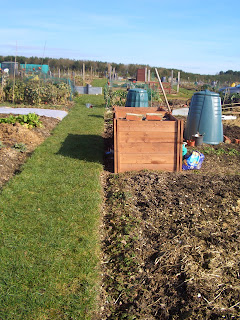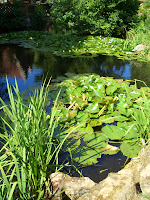 Here begins the story of my vegetable plot.
Here begins the story of my vegetable plot.Three years ago, in winter 2007/2008, I became the proud lessee of a patch of ground in the middle of a grassy and oh so stony field. I had walked over the field earlier in 2007, when negotiations were progressing between the potential landlord and our allotment association, and it felt like I was walking over a kind of gloopy sinking mud, and that any moment this awful stuff was going to part me from my wellington boots.
There were no worms to be seen in the soil, and no birds in the air above us. It seemed a pretty barren field. But most of us were undaunted by such an unpromising start!
Our wonderful committee not only marked out our plots but gave them all a very rough dig with a rotavator. We were also lucky to have an unlimited supply of cow manure from a local dairy farmer. So that first winter the wise amongst us put that manure to good use and covered our plots with it - barrow load after barrow load of this stuff was carted across the field to our plots, and spread thickly, to be left to rot down over the winter months.

....and what a difference this thick winter manure dressing made! Those few who for whatever reason had not heeded the advice of our chairman and had not taken advantage of the freely available mulch found that, come the spring of 2008, their plot resembled a badly overgrown lawn - thick matted weeds and grass - well let's face it, an arable field. Not so much of a surprise there, but some budding gardeners never really caught up after that, and appear to still struggle to keep their weeds at bay.
As the old saying goes, one year's seeding is seven years' weeding. How very true.
Whereas those of us who had worked so hard in the winter cold that first year were handsomely rewarded. Sorry if I sound smug:

I even planted a few flowers - primulas - in the muddy cold clay - as a harbinger of that first spring that held so much promise for us all.
And the all important compost bin had high priority - seen in the distance. I made mine rather inexpertly from wooden pallets and string (!), but later we shall see, perhaps unsurprisingly, that it did not survive for very long.
I cannot remember why I covered part of the ground with fleece at that stage. Obviously I wanted to warm the ground for something, but goodness knows what!
My allotment had got off to a promising start.In later posts I shall chart progress - how I marked out the plot, and why, the mistakes I made and the triumphs, the tears and the fun of it all, the camaraderie and the bleaker moments when thieves broke in. There is so much to tell.
And the rewards are huge. This last few weeks I have picked 50 or 60 pounds or more of the most delicious strawberries - they have been frozen, made into crumble with rhubarb, consumed fresh in vast quantities at every possible opportunity, and given away to all and sundry. And they have seen no nasty chemical pesticides to taint them. They are pure and as far as possible organic. And that is a huge bonus!


























